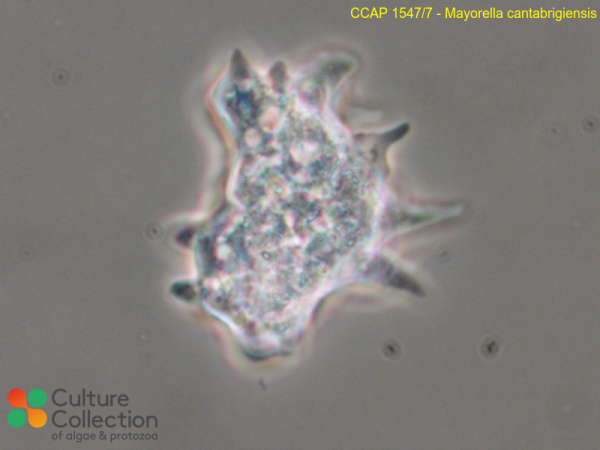References [ 2 ]
Smirnov AV, Chao E, Nassonova ES & Cavalier-Smith T (2011) A revised classification of naked lobose amoebae (Amoebozoa: Lobosa). Protist 162: 545-570.
Tekle YI & Wood FC (2017) Longamoebia is not monophyletic: Phylogenomic and cytoskeleton analyses provide novel and well-resolved relationships of amoebozoan subclades Molecular Phylogenetics and Evolution 114: 249-260.
Division/Phylum: Amoebozoa Class: Discosea
Note: for strains where we have DNA barcodes we can be reasonably confident of identity, however for those not yet sequenced we rely on morphology
and the original identification, usually made by the depositor. Although CCAP makes every effort to ensure the correct taxonomic identity of strains, we cannot guarantee
that a strain is correctly identified at the species, genus or class levels. On this basis users are responsible for confirming the identity of the strain(s) they receive
from us on arrival before starting experiments.
For strain taxonomy we generally use AlgaeBase for algae and
Adl et al. (2019) for protists.
| Attributes |
| Authority | Page 1983 |
| Isolator | Page (1981) |
| Collection Site | Cambridge Botanic Garden, Cambridge Univ., England, UK |
| Climatic Zone |
Temperate |
| Notes |
Images 1-6 by Alexey Smirnov, St. Petersburg University; isolation via cloning |
| Axenicity Status |
Bacteria and other organisms present |
| Area |
Europe |
| Country |
UK |
| Environment |
Freshwater |
| GMO |
No |
| Group |
Protozoa |
| In Scope of Nagoya Protocol |
No |
| ABS Note |
Collected pre Nagoya Protocol. No known Nagoya Protocol restrictions for this strain. |
| Collection Date |
1981 |
| Original Designation |
308 |
| Pathogen |
Not pathogenic: Hazard Class 1 |
| Strain Maintenance Sheet |
|
| Toxin Producer |
Not Toxic / No Data |
| Type Culture |
Yes |
| Taxonomy WoRMS ID |
|






